Family : Achiridae

Text © Giuseppe Mazza

English translation by Mario Beltramini
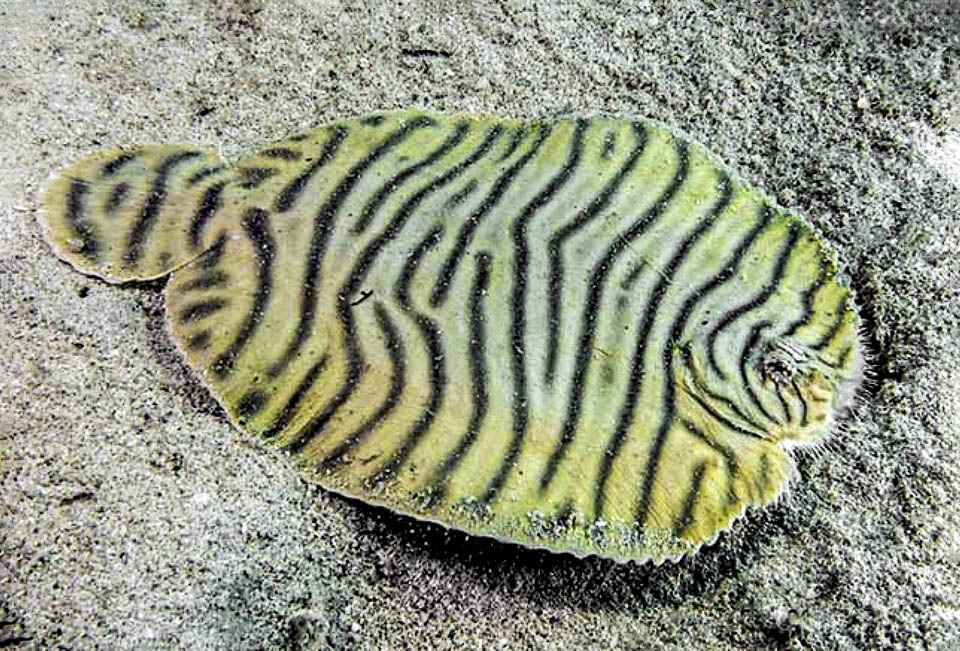
Gymnachirus nudus is a small scaleless American sole present from Mexico and Cuba to Rio Grande do Sul in Brazil at the boundary with Uruguay © Mickey Charteris
Gymnachirus nudus Kaup, 1858, belongs to the class of the Actinopterygii, the ray-finned fishes, to the order of the Pleuronectiformes, the one of the flatfishes, rich in more than 800 species, often important for the human nutrition like the European plaice (Pleuronectes platessa), from which it gets the name, assigned to 16 families: Achiridae, Achiropsettidae, Bothidae, Citharidae, Cyclopsettidae, Cynoglossidae, Oncopteridae, Paralichthodidae, Paralichthyidae, Pleuronectidae, Poecilopsettidae, Psettodidae, Rhombosoleidae, Samaridae, Scophthalmidae and Soleidae.
Gymnachirus nudus has been placed into the Achiridae, the American soles, a small group counting 7 genera and 35 species, 15 cm long on average and mostly marine, but with some members in the fresh waters where the bigger ones do live.
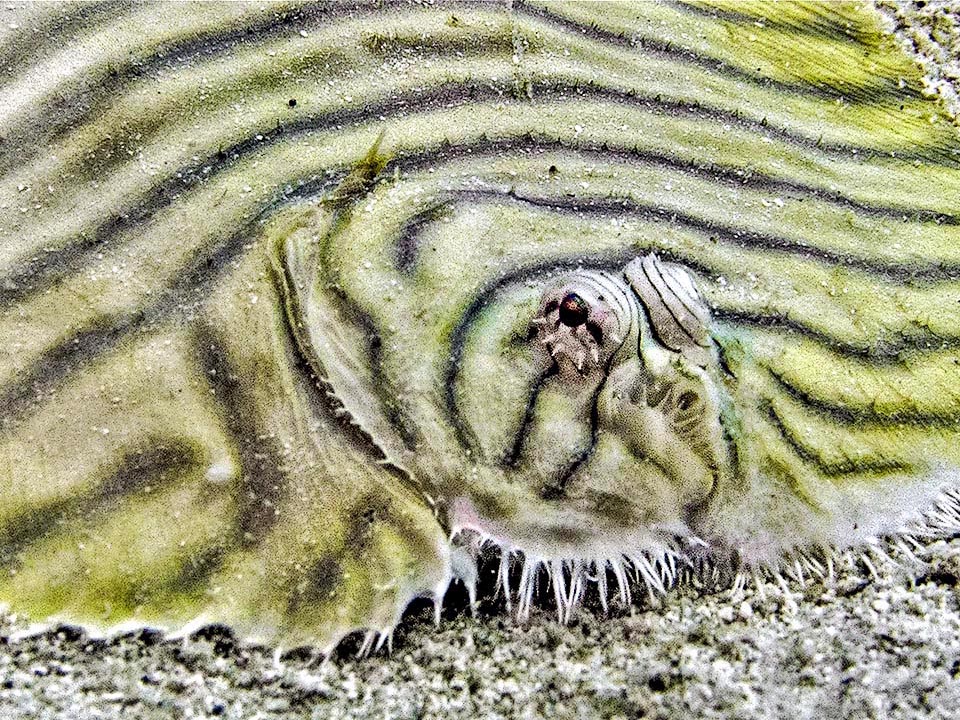
Unlike the Lefteye flounders, it is found resting on the seabeds on the right side. The eyes, small and close-set, are therefore on the left side. To note here the fraying of the upper jaw and the anterior tubular nostril. Over the operculum is also visible what remains of the dorsal pectoral fin, absent or with 1-2 rudimentary rays © Mickey Charteris
Unlike what generally happens in the Bothidae, the Plate fishes like Bothus lunatus, when the metamorphosis is over, the eye of the larvae of the Achiridae does not migrate to the right side, but to the left with the fish leaning on the right side.
The name of the genus Gymnachirus, originates from the Greek “gymnos”, naked, and from the genus Achirus, created by Lacépède in 1802 for a similar fish of the same family, it is therefore a naked Achirus, having no scales.
The specific name nudus, naked in Latin, reinforces the concept.
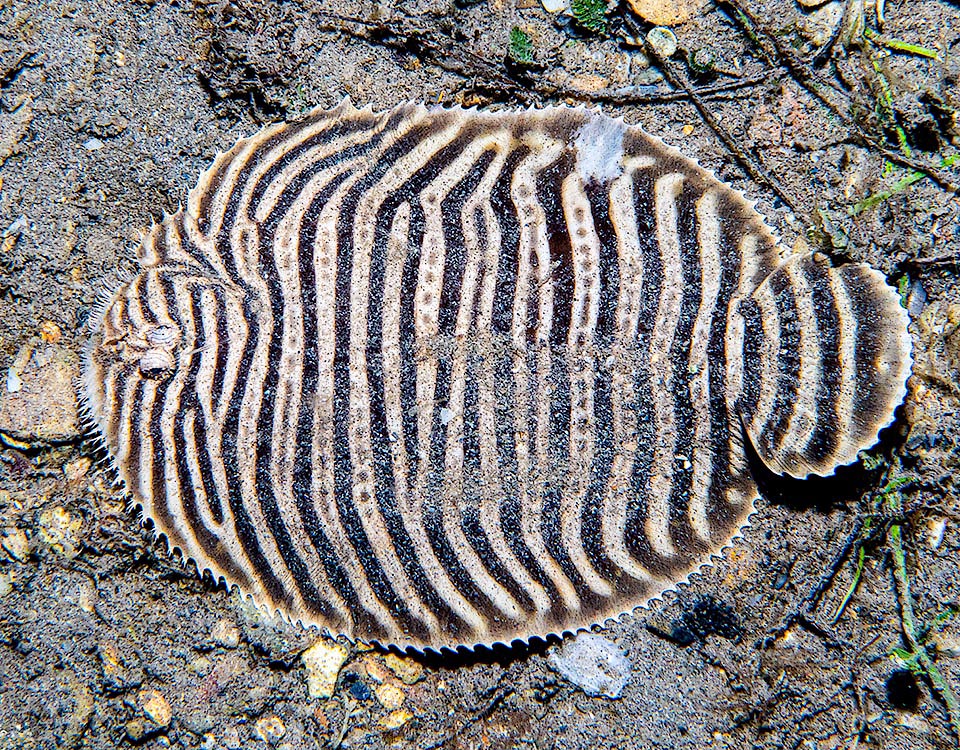
The zebra-mimic livery in the adults has 13-21 dark vertical bands on the side of the eyes, narrower than the clear ones that sometimes have in the centre a thin dotted line © Brian Cole
Zoogeography
Gymnachirus nudus is present along the western Atlantic coasts, from Mexico to Cuba and the Caribbean Sea, in Venezuela, Guyana, Suriname and Brazil up to Rio Grande do Sul that marks the boundary with Uruguay.
Ecology-Habitat
It’s a fish living on detrital, sandy or muddy bottoms, in coastal waters between 2 and about 130 m of depth.
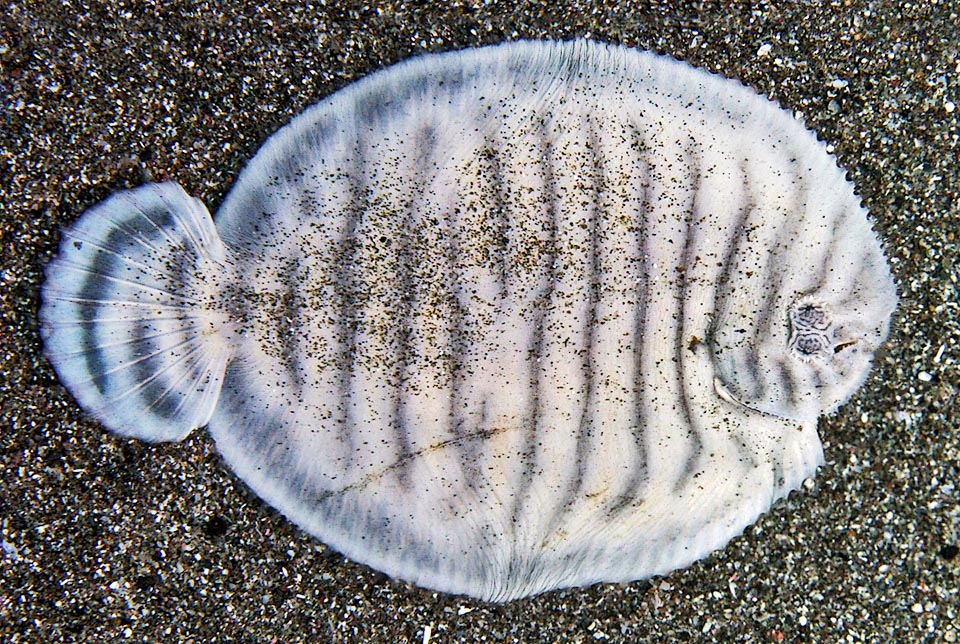
The background colour may be also whitish. The tail, separated from the body, appears roundish with the spread fins © Allison & Carlos Estape
Morphophysiology
Gymnachirus nudus can reach the length of 15-20 cm, but the current size is around 12 cm.
The flat and roundish body with spread fins, covered by loose skin, in the adults has 13-21 dark vertical bands on the side of the eyes, narrower than the clear ones that separate them and have at times in the centre a thin dotted line. A zebra-mimic livery that continues also on the fins and at times merges towards the borders forming a dark contour. The background colour is changeable: yellowish, beige, brown or black.
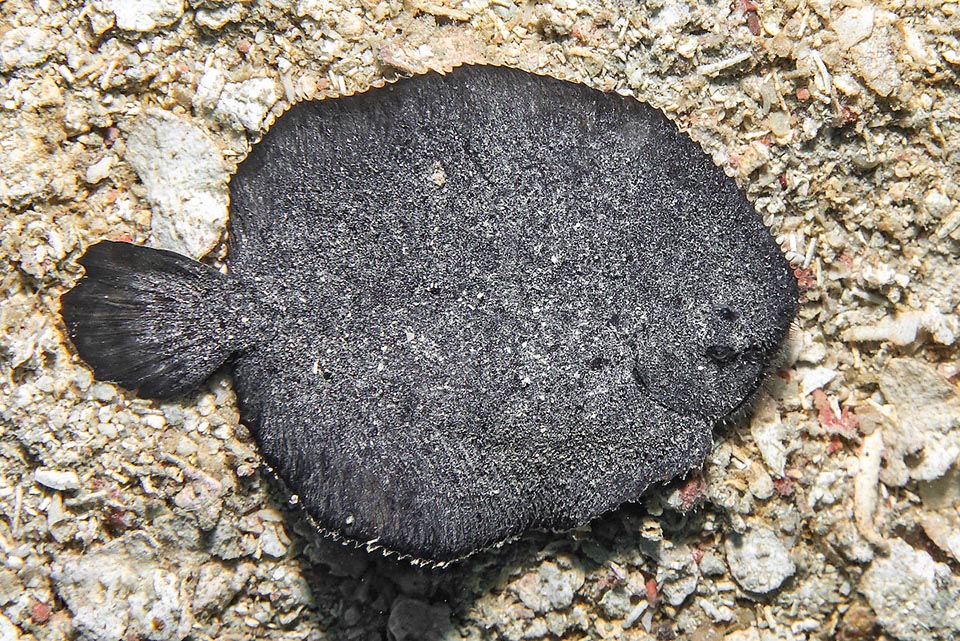
Also very dark specimens are not missing where the mimetic drawing is poorly visible, especially when, loke here it is dusty © Allison & Carlos Estape
The side on which it rests on the seabed is as always clear, but in the early days the juveniles of Gymnachirus nudus appear almost completely black on both sides.
The fins have only soft rays: 61-69 on the dorsal extending forward on the head up to the upper jaw characterized by a fringed dermal flap, and 44-50 on the anal.
The pectoral ones, at times absent, have 1-2 rudimentary rays and the pelvic of the ocular side, with 5 rays, is united with the anal by a membrane. The caudal fin is separate from the others.
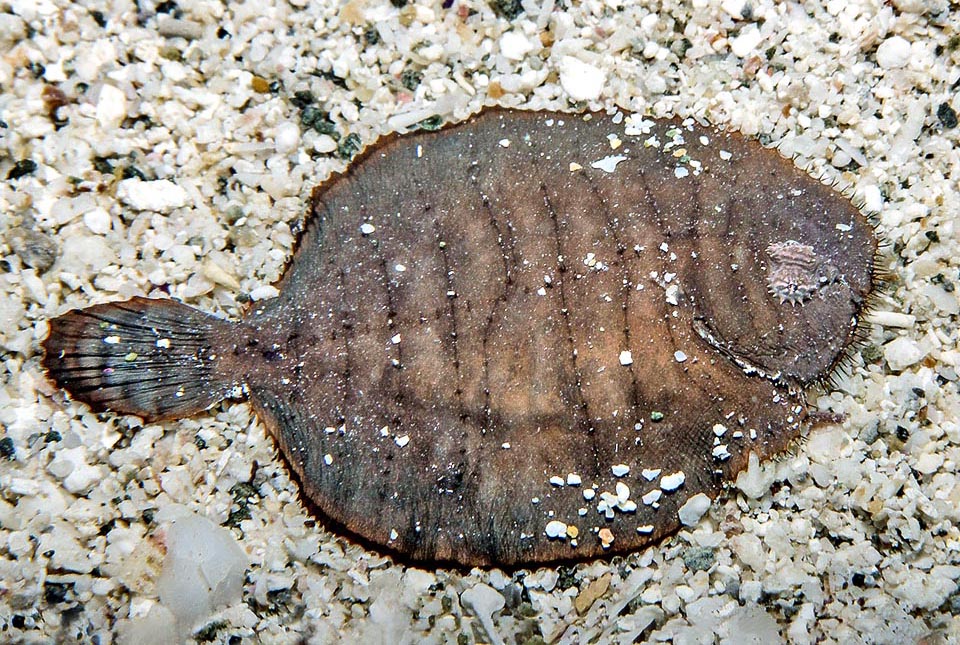
Here we note well the lateral line reaching the head with an unusual perpendicular ramification: 7-10 almost parallel lines with visible the remains of the sensory scales © Allison & Carlos Estape
The lateral line present on the right side reaches the head with an unusual perpendicular ramification: 7-10 almost parallel lines with, visible, the remainders of the sensory scales.
The small villiform teeth are placed on the blind side of the jaws. The anterior nostril is tubular and the posterior forms an ample longitudinal opening on the back of the upper lip visible only when the mouth is open.
Lifting the operculum or during the movements on the ground we note a small circular hole close to the operculum from where the water gets out.
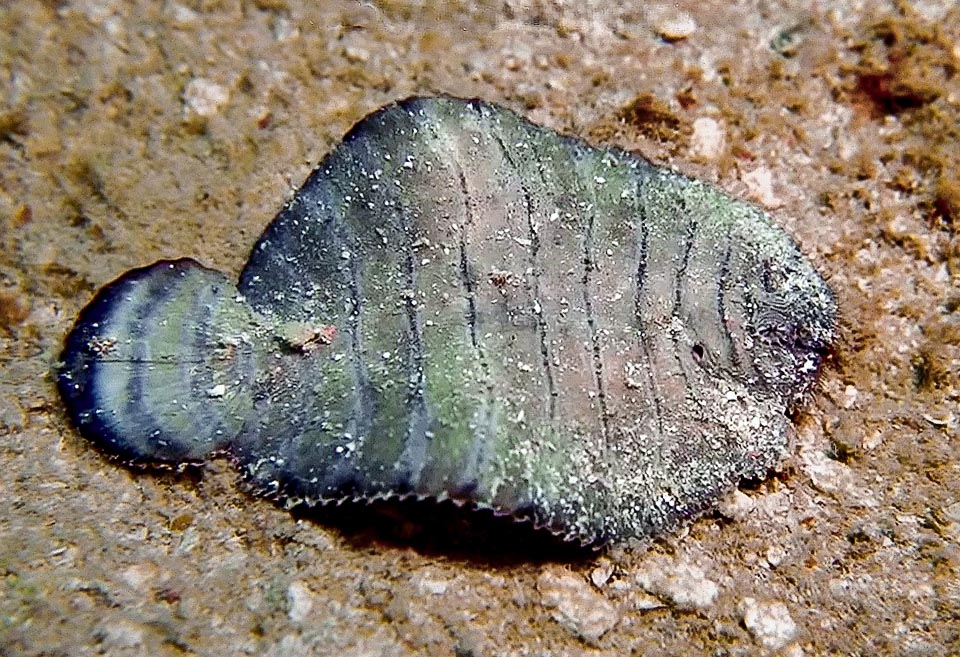
Looking for food it goes ahead with compass-like movements. Here we note a small circular hole close to operculum from were water gets out after having oxygenated gills © Mickey Charteris
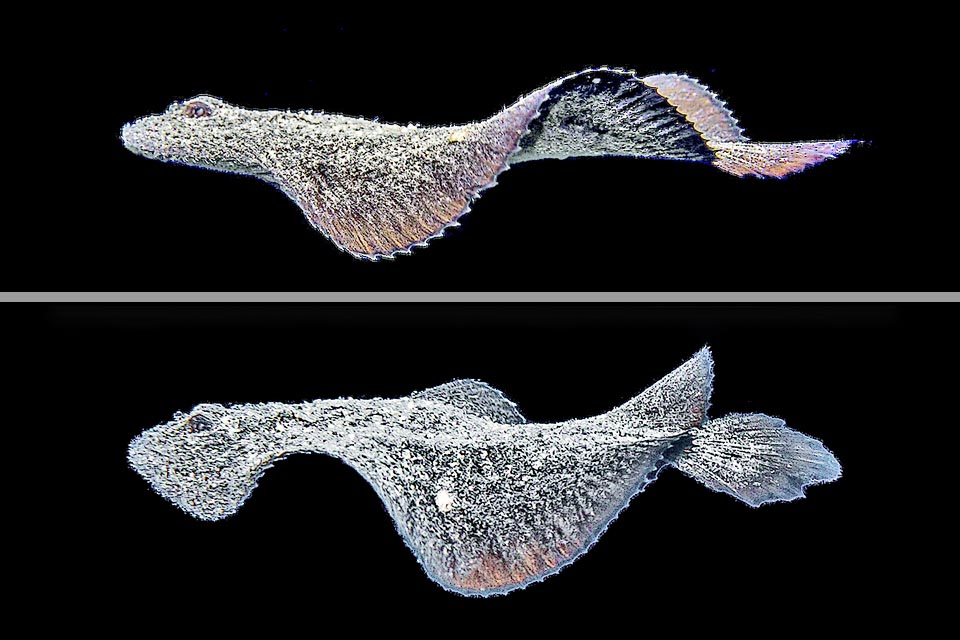
However Gymnachirus nudus may also swim for short distances with the undulating movement of the fins © Allison & Carlos Estape
Ethology-Reproductive Biology
Gymnachirus nudus nourishes of benthic invertebrates and small fishes it looks for by advancing often with compass-like movements on the seabeds. In the small aquaria, where it has often been observed, it also ascends resting on the vertical glasses and shows, waving the fins, to be able to swim.
Little is known about its reproduction, apart from the planktonic larval state with the eyes, initially, on the two sides.
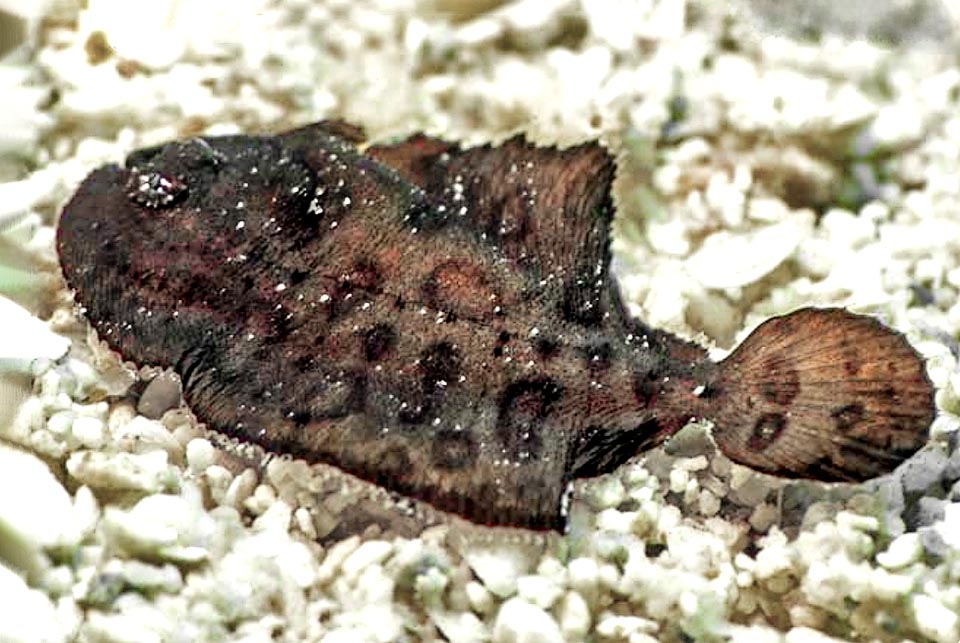
Initially juveniles’ colour is almost black on both sides. Then some dark drawings appear and finally the hatching. Here we already note the lateral line © Mickey Charteris
Theoretically, it’s an edible fish, but of poor value because there is very little to eat. Sometimes it ends up into the trawl nets for shrimps to the disappointment of the fishermen because it clogs up the mesh of the nets.
The resilience of the species is high with a possible doubling of the populations in less than 15 months. The fishing vulnerability, very low, marks only 10 on a scale of 100.
Although it is moderately rare, considering in addition the high diffusion, Gymnachirus nudus consequently appears from 2012 as “LC, Least Concern” in the IUCN Red List of the endangered species.
→ For general information about FISH please click here.
→ For general information about BONY FISH please click here
→ For general information about CARTILAGINOUS FISH please click here.
→ To appreciate the BIODIVERSITY of BONY FISH please click here.
→ To appreciate the BIODIVERSITY of CARTILAGINOUS FISH please click here.
